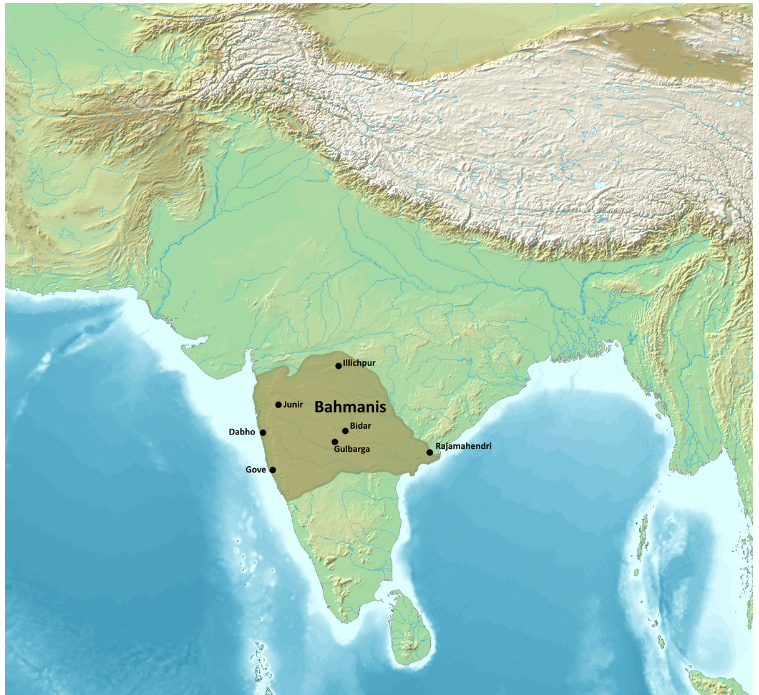
The Bahmani Sultanate, founded by Hasan Gangu Bahmani, marked the dawn of an independent Muslim realm in the Deccan region of southern India. Its inception stemmed from the successful uprising against Muhammad Bin Tughlaq in 1327 A.D.
The territories of Andhra Pradesh, Karnataka, and Maharashtra were integrated into the burgeoning Bahmani Sultanate. Initially established in Gulbarga, the capital was later relocated to Bidar.
Administratively, the governance model mirrored a Feudal Government structure. Provinces or states within the Sultanate were referred to as Tarafs. The official language of the Sultanate was Persian, though local languages like Urdu, Deccani, Marathi, Telugu, and Kannada were commonly used.
Significant Rulers of Bahmani Kingdom
1. Hasan Gangu Bahmani
Hasan Gangu Bahmani, hailing from a Turkish background, rose from the ranks of a military officer under Muhammad Bin Tughlaq to establish the illustrious Bahmani kingdom in 1347 A.D.
His realm extended from the Arabian Sea to the Bay of Bengal, encompassing the entirety of the Deccan region up to the river Krishna, with Devagiri as its capital.
2. Muhammad Shah I (1358-1377 A.D.)
Succeeding his father, Muhammad Shah I ascended to the throne as the second ruler of the Bahmani Kingdom, exhibiting exceptional prowess as both an administrator and a military strategist.
His triumphs included victories over Bukka-I of Vijayanagar and the Kapila Nayaks of Warangal, solidifying his reign.
3. Muhammad Shah II (1378-1397 A.D.)
Ascending to power in 1378, Muhammad Shah II made significant architectural contributions to the Sultanate, fostering peaceful diplomatic relations with neighboring states.
His benevolent rule saw the establishment of hospitals for public welfare and the construction of numerous educational and religious institutions, exemplifying his commitment to social development.
4. Feroz Shah Bahmani (1397-1422 A.D.)
Taj ud-Din Feroz Shah, revered as the pinnacle of Bahmani Sultanate leadership, distinguished himself through military conquests, notably defeating Deva Raya I of the Vijayanagara Empire and founding the city of Firozabad.
His patronage of arts, literature, and culture left an indelible mark on the Sultanate's legacy, promoting intellectual and artistic endeavors throughout his reign.
5. Ahmad Shah (1422-1435 A.D.)
Succeeding Feroz Shah Bahmani, Ahmad Shah's rule was marked by a ruthless and authoritarian demeanor, exemplified by his brutal conquest of the kingdom of Warangal and his relocation of the capital to Bidar.
His reign was characterized by a firm grip on power, albeit marred by his harsh governance style, which ultimately led to his demise in 1435 A.D.
6. Muhammad Shah III (1463-1482 A.D.)
Ascending to the throne at a tender age in 1463 A.D., Muhammad Shah III's early reign saw the capable stewardship of Muhammad Gawan, whose adept leadership bolstered the Sultanate's strength.
Under Muhammad Gawan's , the Bahmani kingdom flourished, achieving notable victories against rival powers, including Orissa, Konkan, Sangameshwar, and Vijayanagar.
7. Muhammad Gawan
Regarded as a paragon of administrative excellence and erudition, Muhammad Gawan transformed the Bahmani Sultanate through systematic financial reforms, educational initiatives, and military discipline.
His relentless crusade against corruption and emphasis on good governance laid the groundwork for a prosperous and resilient Sultanate, although his tragic end in 1481 marked a tumultuous period for the Bahmani dynasty.
Muhammad Shah III's demise in 1482 precipitated the decline of the Bahmani Sultanate, leading to its fragmentation into successor states, each with its own distinct lineage and rulers. These included:
- Adilshahis of Bijapur
- Nizam Shahis of Ahmednagar
- Qutub Shahis of Golconda
- Imadshahis of Bera
- Baridshahis of Bidar

